 |
Chris Bell | 'All I ask for is the chance to prove that money can't make me happy.' |
| - Spike Milligan |
 |
Chris Bell | 'All I ask for is the chance to prove that money can't make me happy.' |
| - Spike Milligan |
You will stay on this website. Do not refresh your browser, or you will have to visit Changelly.com to see your exchange progress.
Shortcut Scroll-Down Menu
Ethereum is an open-source, public, blockchain-based distributed computing platform and operating system featuring smart contract (scripting) functionality. It supports a modified version of Nakamoto consensus via transaction-based state transitions.
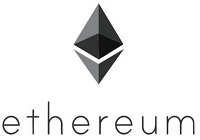
Ether is a cryptocurrency whose blockchain is generated by the Ethereum platform. Ether can be transferred between accounts and used to compensate participant mining nodes for computations performed. Ethereum provides a decentralized Turing-complete virtual machine, the Ethereum Virtual Machine (EVM), which can execute scripts using an international network of public nodes. "Gas", an internal transaction pricing mechanism, is used to mitigate spam and allocate resources on the network.
Ethereum was proposed in late 2013 by Vitalik Buterin, a cryptocurrency researcher and programmer. Development was funded by an online crowdsale that took place between July and August 2014. The system went live on 30 July 2015, with 11.9 million coins "premined" for the crowdsale. This accounts for about 13 percent of the total circulating supply. In 2016, as a result of the collapse of The DAO project, Ethereum was split into two separate blockchains – the new separate version became Ethereum (ETH), and the original continued as Ethereum Classic (ETC). The value of the Ethereum currency grew over 13,000 percent in 2017.
Vitalik Buterin picked the name Ethereum after browsing Wikipedia articles about elements and science fiction, when he found the name, noting, "I immediately realized that I liked it better than all of the other alternatives that I had seen; I suppose it was the fact that sounded nice and it had the word 'ether', referring to the hypothetical invisible medium that permeates the universe and allows light to travel."
Ethereum was initially described in a white paper by Vitalik Buterin, a programmer involved with Bitcoin Magazine, in late 2013 with a goal of building decentralized applications. Buterin had argued that Bitcoin needed a scripting language for application development. Failing to gain agreement, he proposed development of a new platform with a more general scripting language.
At the time of public announcement in January 2014, the core Ethereum team was Vitalik Buterin, Mihai Alisie, Anthony Di Iorio, and Charles Hoskinson. Formal development of the Ethereum software project began in early 2014 through a Swiss company, Ethereum Switzerland GmbH (EthSuisse). Subsequently, a Swiss non-profit foundation, the Ethereum Foundation (Stiftung Ethereum), was created as well. Development was funded by an online public crowdsale during July–August 2014, with the participants buying the Ethereum value token (ether) with another digital currency, bitcoin. While there was early praise for the technical innovations of Ethereum, questions were also raised about its security and scalability.
In March 2017, various blockchain start-ups, research groups, and Fortune 500 companies announced the creation of the Enterprise Ethereum Alliance (EEA) with 30 founding members. By May, the nonprofit organization had 116 enterprise members—including ConsenSys, CME Group, Cornell University's research group, Toyota Research Institute, Samsung SDS, Microsoft, Intel, J. P. Morgan, Cooley LLP, Merck KGaA, DTCC, Deloitte, Accenture, Banco Santander, BNY Mellon, ING, and National Bank of Canada. By July 2017, there were over 150 members in the alliance, including recent additions MasterCard, Cisco Systems, Sberbank and Scotiabank.
Several codenamed prototypes of the Ethereum platform were developed by the Foundation, as part of their Proof-of-Concept series, prior to the official launch of the Frontier network. "Olympic" was the last of these prototypes, and public beta pre-release. The Olympic network provided users with a bug bounty of 25,000 ether for stress testing the limits of the Ethereum blockchain. "Frontier" marked the tentative experimental release of the Ethereum platform in July 2015.
Since the initial launch, Ethereum has undergone several planned protocol upgrades, which are important changes affecting the underlying functionality and/or incentive structures of the platform. Protocol upgrades are accomplished by means of a soft fork of the open source code base. "Homestead" was the first to be considered stable. It included improvements to transaction processing, gas pricing, and security and the soft fork occurred on 31 July 2015.
The "Metropolis Part 1: Byzantium" soft fork took effect on 16 October 2017, and included changes to reduce the complexity of the EVM and provide more flexibility for smart contract developers.[32] Byzantium also adds supports for zk-SNARKs (from Zcash); with the first zk-SNARK transaction occurring on testnet on September 19, 2017. There are at least two other protocol upgrades planned in the future: "Metropolis Part 2: Constantinople" will lay the foundations for the transition to proof-of-stake (Casper).
In 2016 a decentralized autonomous organization called The DAO, a set of smart contracts developed on the platform, raised a record US$150 million in a crowdsale to fund the project. The DAO was exploited in June when US$50 million in ether were claimed by an anonymous entity. The event sparked a debate in the crypto-community about whether Ethereum should perform a contentious "hard fork" to reappropriate the affected funds. As a result of the dispute, the network split in two. Ethereum (the subject of this article) continued on the forked blockchain, while Ethereum Classic continued on the original blockchain. The hard fork created a rivalry between the two networks. After the hard fork related to The DAO, Ethereum subsequently forked twice in the fourth quarter of 2016 to deal with other attacks. By the end of November 2016, Ethereum had increased its DDoS protection, de-bloated the blockchain, and thwarted further spam attacks by hackers.
Ether is a fundamental cryptocurrency for operation of Ethereum, which thereby provides a public distributed ledger for transactions. It is used to pay for gas, a unit of computation used in transactions and other state transitions. Mistakenly, this currency is also referred to as Ethereum. It is listed under the code ETH and traded on cryptocurrency exchanges, and the Greek uppercase Xi character (Ξ) is generally used for its currency symbol. It is also used to pay for transaction fees and computational services on the Ethereum network.
As with other cryptocurrencies, the validity of each ether is provided by a blockchain, which is a continuously growing list of records, called blocks, which are linked and secured using cryptography. By design, the blockchain is inherently resistant to modification of the data. It is an open, distributed ledger that records transactions between two parties efficiently and in a verifiable and permanent way. Unlike Bitcoin, Ethereum operates using accounts and balances in a manner called state transitions. This does not rely upon unspent transaction outputs (UTXOs). State denotes the current balances of all accounts and extra data. State is not stored on the blockchain, it is stored in a separate Merkle Patricia tree. A cryptocurrency wallet stores the public and private "keys" or "addresses" which can be used to receive or spend Ether. These can be generated through BIP 39 style mnemonics for a BIP 32 "HD Wallet". In Ethereum, this is unnecessary as it does not operate in a UTXO scheme. With the private key, it is possible to write in the blockchain, effectively making an ether transaction. To send ether to an account, you need the public key of that account. Ether accounts are pseudonymous in that they are not linked to individual persons, but rather to one or more specific addresses. Owners can store these addresses in software, on paper and possibly in memory ("brain wallet").
Ethereum addresses are composed of the prefix "0x", a common identifier for hexadecimal, concatenated with the rightmost 20 bytes of the Keccak-256 hash (big endian) of the ECDSA public key. In hexadecimal, 2 digits represents a byte, meaning addresses contain 40 hexadecimal digits. One example is 0xb794F5eA0ba39494cE839613fffBA74279579268, the Poloniex ColdWallet. Contract addresses are in the same format, however they are determined by sender and creation transaction nonce. User accounts are indistinguishable from contract accounts given only an address for each and no blockchain data. Any valid Keccak-256 hash put into the described format is valid, even if it does not correspond to an account with a private key or a contract. This is unlike Bitcoin, which uses base58check to ensure that addresses are properly typed.
Ether is different from Bitcoin (the cryptocurrency with the largest market capitalization as of June 2018) in several aspects:
The total supply of ether was Ξ100 million as of June 2018. In 2017, mining generated 9.2 million new ether, corresponding to a 10% increase in its total supply. Casper FFG and CBC are expected to reduce the inflation rate to between 0.5% to 2%. There is no currently implemented hard cap on the total supply of ETH, but it is expected to end at a certain point, and become deflationary.
Ether can be traded by regular currency brokers, cryptocurrency exchanges, as well as many online cryptocurrency wallets. As of January 2018, at least 150 stores accept ether.
The Ethereum Virtual Machine (EVM) is the runtime environment for smart contracts in Ethereum. It is a 256-bit register stack, designed to run the same code exactly as intended. It is the fundamental consensus mechanism for Ethereum. The formal definition of the EVM is specified in the Ethereum Yellow Paper. It is sandboxed and also completely isolated from the network, filesystem or other processes of the host computer system. Every Ethereum node in the network runs an EVM implementation and executes the same instructions. In February 1, 2018, there were 27,500 nodes in the main Ethereum network. Ethereum Virtual Machines have been implemented in C++, Go, Haskell, Java, JavaScript, Python, Ruby, Rust, and WebAssembly (currently under development).
Ethereum's smart contracts are based on different computer languages, which developers use to program their own functionalities.[66] Smart contracts are high-level programming abstractions that are compiled down to EVM bytecode and deployed to the Ethereum blockchain for execution. They can be written in Solidity (a language library with similarities to C and JavaScript), Serpent (similar to Python, but deprecated), LLL (a low-level Lisp-like language), and Mutan (Go-based, but deprecated). There is also a research-oriented language under development called Viper (a strongly-typed Python-derived decidable language).
Smart contracts can be public, which opens up the possibility to prove functionality, e.g. self-contained provably fair casinos. One issue related to using smart contracts on a public blockchain is that bugs, including security holes, are visible to all but cannot be fixed quickly. One example of this is the 17 June 2016 attack on The DAO, which could not be quickly stopped or reversed. There is ongoing research on how to use formal verification to express and prove non-trivial properties. A Microsoft Research report noted that writing solid smart contracts can be extremely difficult in practice, using The DAO hack to illustrate this problem. The report discussed tools that Microsoft had developed for verifying contracts, and noted that a large-scale analysis of published contracts is likely to uncover widespread vulnerabilities. The report also stated that it is possible to verify the equivalence of a Solidity program and the EVM code.
Ethereum is written in Turing complete language, which includes seven different programming languages. Developers use the language to create and publish applications which they know will run inside Ethereum. It's a cumbersome system, but that's not deterring developers from writing Ethereum programs. Ethereum blockchain applications are usually referred to as DApps (decentralized application), since they are based on the decentralized Ethereum Virtual Machine, and its smart contracts. Many uses have been proposed for Ethereum platform, including ones that are impossible or unfeasible. Use case proposals have included finance, the internet-of-things, farm-to-table produce, electricity sourcing and pricing, and sports betting. Ethereum is (as of 2017) the leading blockchain platform for initial coin offering projects, with over 50% market share. As of January 2018, there are more than 250 live DApps, with hundreds more under development. Some application examples include: digital signature algorithms, securitized tokens, digital rights management, crowdfunding, prediction markets, remittance, online gambling, social media platforms, financial exchanges and identity systems.
https://en.wikipedia.org/wiki/Ethereum

If you want to know what Ethereum is, how it works, and what it can be used for, without going deep into the technical abyss, this guide is perfect for you. Important Note: This guide assumes a basic understanding of blockchain technology. If you're unfamiliar with blockchain, check out this step by step introduction for beginners.
Although commonly associated with Bitcoin, blockchain technology has many other applications that go way beyond digital currencies. In fact, Bitcoin is only one of several hundred applications that use blockchain technology today.

Until relatively recently, building blockchain applications has required a complex background in coding, cryptography, mathematics as well as significant resources. But times have changed. Previously unimagined applications, from electronic voting & digitally recorded property assets to regulatory compliance & trading are now actively being developed and deployed faster than ever before. By providing developers with the tools to build decentralized applications, Ethereum is making all of this possible.
At its simplest, Ethereum is an open software platform based on blockchain technology that enables developers to build and deploy decentralized applications. (Buy Ethereum)
Like Bitcoin, Ethereum is a distributed public blockchain network. Although there are some significant technical differences between the two, the most important distinction to note is that Bitcoin and Ethereum differ substantially in purpose and capability. Bitcoin offers one particular application of blockchain technology, a peer to peer electronic cash system that enables online Bitcoin payments. While the Bitcoin blockchain is used to track ownership of digital currency (bitcoins), the Ethereum blockchain focuses on running the programming code of any decentralized application.
In the Ethereum blockchain, instead of mining for bitcoin, miners work to earn Ether, a type of crypto token that fuels the network. Beyond a tradeable cryptocurrency, Ether is also used by application developers to pay for transaction fees and services on the Ethereum network.
There is a second type of token that is used to pay miners fees for including transactions in their block, it is called gas, and every smart contract execution requires a certain amount of gas to be sent along with it to entice miners to put it in the blockchain.

Smart contract is just a phrase used to describe computer code that can facilitate the exchange of money, content, property, shares, or anything of value. When running on the blockchain a smart contract becomes like a self-operating computer program that automatically executes when specific conditions are met. Because smart contracts run on the blockchain, they run exactly as programmed without any possibility of censorship, downtime, fraud or third party interference.
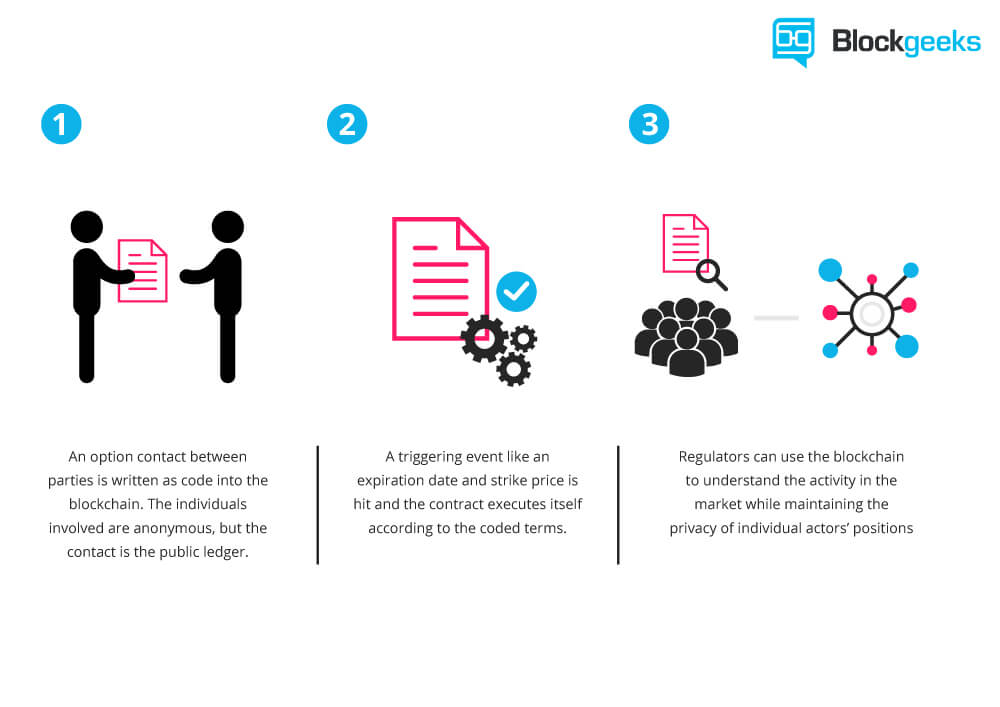
While all blockchains have the ability to process code, most are severely limited. Ethereum is different. Rather than giving a set of limited operations, Ethereum allows developers to create whatever operations they want. This means developers can build thousands of different applications that go way beyond anything we have seen before.

Before the creation of Ethereum, blockchain applications were designed to do a very limited set of operations. Bitcoin and other cryptocurrencies, for example, were developed exclusively to operate as peer-to-peer digital currencies. Developers faced a problem. Either expand the set of functions offered by Bitcoin and other types of applications, which is very complicated and time-consuming, or develop a new blockchain application and an entirely new platform as well. Recognizing this predicament, Ethereum's creator, Vitalik Buterin developed a new approach.

Ethereum's core innovation, the Ethereum Virtual Machine (EVM) is a Turing complete software that runs on the Ethereum network. It enables anyone to run any program, regardless of the programming language given enough time and memory. The Ethereum Virtual Machine makes the process of creating blockchain applications much easier and efficient than ever before. Instead of having to build an entirely original blockchain for each new application, Ethereum enables the development of potentially thousands of different applications all on one platform.
Ethereum enables developers to build and deploy decentralized applications. A decentralized application or Dapp serve some particular purpose to its users. Bitcoin, for example, is a Dapp that provides its users with a peer to peer electronic cash system that enables online Bitcoin payments. Because decentralized applications are made up of code that runs on a blockchain network, they are not controlled by any individual or central entity.
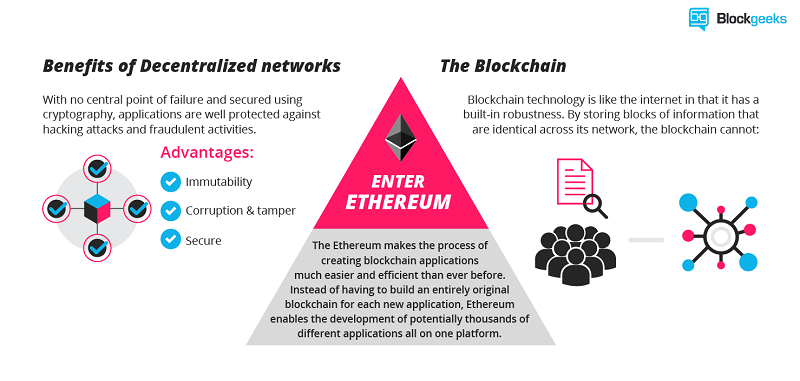
Any services that are centralized can be decentralized using Ethereum. Think about all the intermediary services that exist across hundreds of different industries. From obvious services like loans provided by banks to intermediary services rarely thought about by most people like title registries, voting systems, regulatory compliance and much more.
Ethereum can also be used to build Decentralized Autonomous Organizations (DAO). A DAO is fully autonomous, decentralized organization with no single leader. DAO's are run by programming code, on a collection of smart contracts written on the Ethereum blockchain. The code is designed to replace the rules and structure of a traditional organization, eliminating the need for people and centralized control. A DAO is owned by everyone who purchases tokens, but instead of each token equating to equity shares & ownership, tokens act as contributions that give people voting rights.
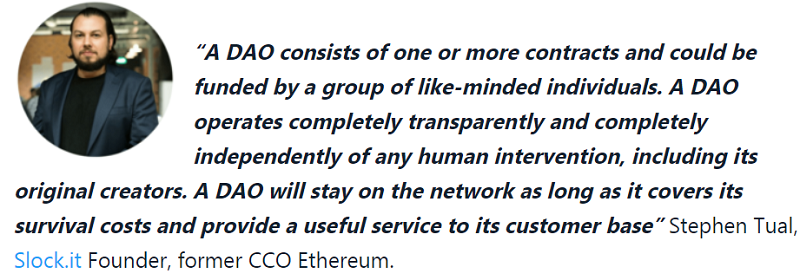
Ethereum can also be used to build Decentralized Autonomous Organizations (DAO). A DAO is fully autonomous, decentralized organization with no single leader. DAO's are run by programming code, on a collection of smart contracts written on the Ethereum blockchain. The code is designed to replace the rules and structure of a traditional organization, eliminating the need for people and centralized control. A DAO is owned by everyone who purchases tokens, but instead of each token equating to equity shares & ownership, tokens act as contributions that give people voting rights.
Ethereum has recently created a new standard called the ERC721 token for tracking unique digital assets. One of the biggest use cases currently for such tokens are digital collectibles, as the infrastructure allows for people to prove ownership of scarce digital goods. Many games are currently being built using this technology, such as the overnight hit CryptoKitties, a game where you can collect and breed digital cats.
Because decentralized applications run on the blockchain, they benefit from all of its properties.
Despite bringing a number of benefits, decentralized applications aren't faultless. Because smart contract code is written by humans, smart contracts are only as good as the people who write them. Code bugs or oversights can lead to unintended adverse actions being taken. If a mistake in the code gets exploited, there is no efficient way in which an attack or exploitation can be stopped other than obtaining a network consensus and rewriting the underlying code. This goes against the essence of the blockchain which is meant to be immutable. Also, any action taken by a central party raises serious questions about the decentralized nature of an application.
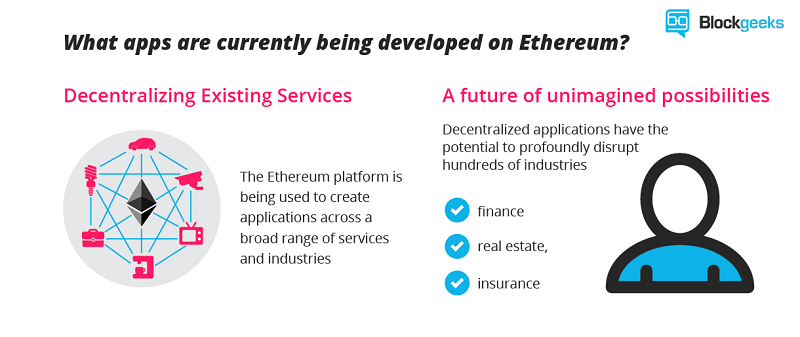
There are many ways you can plug into the Ethereum network, one of the easiest ways is to use its native Mist browser. Mist provides a user-friendly interface & digital wallet for users to trade & store Ether as well as write, manage, deploy and use smart contracts. Like web browsers give access and help people navigate the internet, Mist provides a portal into the world of decentralized blockchain applications.
There is also the MetaMask browser extension, which turns Google Chrome into an Ethereum browser. MetaMask allows anyone to easily run or develop decentralized applications from their browser. Although initially built as a Chrome plugin, MetaMask supports Firefox and the Brave Browser as well.
While it's still early days, Mist, MetaMask and a variety of other browsers look set to make blockchain-based applications accessible to more people than ever before. Even people without a technical background can now potentially build blockchain apps. This is a revolutionary leap for blockchain technology that could bring decentralized applications into the mainstream.
The job market is struggling to keep up with the sudden demand for blockchain developers. Some universities and private companies have responded by offering a range of blockchain related courses in an attempt to meet the needs of industry. According to Bitcoin pioneer Jered Kenna, experienced blockchain professionals can net over $200,000 USD in annual income.
"The supply of people that have extensive blockchain experiences is pretty low,” Kenna explained. “And the demand is quickly increasing. Sometimes they get five job offers a day."
As a leader in the blockchain community, Blockgeeks have organized our own courses to help people gain a greater understanding of the technology and prime them for excellent opportunities in the job market. These classes aim to bring students up to speed on blockchain technology, as well as give them practical skills that will help their careers.
This Blockchain Certified Master Course takes students through the fundamentals, giving them a solid foundation that they can build upon, then moves on to more advanced knowledge, teaching them how they can apply blockchain technology in practical situations. By the end of the course, students will be able to create, connect and use their own personal blockchain in AWS. They will be taught how to use MultiChain Streams and also how to create their own blockchain applications.
This course is ideal for:
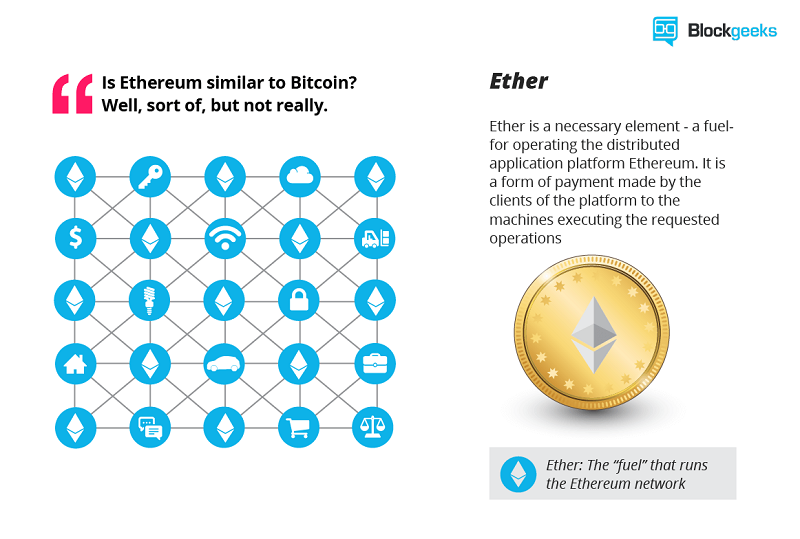
The Ethereum platform is being used to create applications across a broad range of services and industries. But developers are in unchartered territory, so it's hard to know which apps will succeed and which ones will fail. Here are a few exciting projects. Weifund provides an open platform for crowdfunding campaigns that leverages smart contracts. It enables contributions to be turned into contractually backed digital assets that can be used, traded or sold within the Ethereum ecosystem.
Uport provides users with a secure and convenient way to take complete control of their identity and personal information. Instead of relying on government institutions and surrendering their identities to third parties, users control who can access and use their data and personal information. BlockApps is looking to provide the easiest way for enterprises to build, manage and deploy blockchain applications. From the proof of concept to full production systems and integration with legacy systems, Blockapps provides all the tools necessary to create private, semi-private and public industry-specific blockchain applications.
Provenance is using Ethereum to make opaque supply chains more transparent. By tracing the origins and histories of products, the project aims to build an open & accessible framework of information so consumers can make informed decisions when they buy products. Augur is an open-source prediction & forecasting market platform that allows anyone to forecast events and get rewarded for predicting them correctly. Predictions on future real world events, like who will win the next US election, are carried out by trading virtual shares. If a person buys shares in a winning prediction, they receive monetary rewards. To view other projects currently in development on Ethereum, click here.

Remember how Ethereum can be used to build Decentralized Autonomous Organizations? Well in 2016, something bad happened. A startup working on one particular DOA project, aptly named ‘The DAO' got hacked. The DAO was a project developed and programmed by a team behind another startup called Slock.it. Their aim was to build a humanless venture capital firm that would allow investors to make decisions through smart contracts. The DAO was funded through a token sale and ended up raising around $150 million dollars from thousands of different people.
Shortly after the funds were raised, The DAO was hacked by an unknown attacker who stole Ether worth around $50 million dollars at the time. While the attack was made possible by a technical flaw in The DAO software, not the Ethereum platform itself, the developers and founders of Ethereum were forced to deal with the mess.
After much debate, the Ethereum community voted and decided to retrieve the stolen funds by executing what's known as a hard fork or a change in code. The hard fork moved the stolen funds to a new smart contract designed to let the original owners withdraw their tokens. But this is where things get complicated. The implications of this decision are controversial and the topic of intense debate.
Here's why. Ethereum is based on blockchain technology where all transactions are meant to be irreversible and unchangeable. By executing a hard fork and rewriting the rules by which the blockchain executes, Ethereum set a dangerous precedent that goes against the very essence of blockchain. If the blockchain is changed every time a large enough amount of money is involved, or enough people get negatively impacted, the blockchain will lose its main value proposition – secure, anonymous, tamper proof & unchangeable.
While another less aggressive soft fork solution was put forth, the Ethereum community and its founders were placed in a perilous position. If they didn't retrieve the stolen investor money, confidence in Ethereum could be lost. On the other hand, recovering investor money required actions that went against the core ideals of decentralization and set a dangerous precedent.
In the end, the majority of the Ethereum community voted to perform a hard fork, and retrieve The DAO investors money. But not everyone agreed with this course of action. This resulted in a split where two parallel blockchains now exist. For those members who strongly disagree with any changes to the blockchain even when hacking occurs there is Ethereum classic. For the majority who agreed to rewrite a small part of the blockchain and return the stolen money to their owners, there is Ethereum.
Both blockchains have the same features and are identical in every way up to a certain block where the hard-fork was implemented. This means that everything that happened on Ethereum up until the hard-fork is still valid on the Ethereum Classic Blockchain. From the block where the hard fork or change in code was executed onwards, the two blockchains act individually.
Despite the fallout from The DAO hack, Ethereum is moving forward and looking to a bright future. By providing a user-friendly platform that enables people to harness the power of blockchain technology, Ethereum is speeding up the decentralization of the world economy. Decentralized applications have the potential to profoundly disrupt hundreds of industries including finance, real estate, academia, insurance, healthcare and the public sector amongst many others.

"If you think the internet has affected your life, Ethereum will have that same pervasive influence on our communications, on our entire information infrastructure. It's going to impact all aspects of our existence. Building the public Ethereum ecosystem: As scalability and configurable privacy/confidentiality grow on public Ethereum over the next two years, consumers will use their blockchain identity and access point (uPort) to interact with a variety of interesting early stage offerings. Including crowdfunding platforms (Weifund), group governance tools (Boardroom), music/film/art content registration and utilization platforms (ujo), wisdom markets (Gnosis), and gaming apps (Virtue Poker)" - Joseph Lubin, CEO of Consensys
The Ethereum platform is also helping to shift the way we use the Internet. Decentralized applications are pushing a fundamental change from an Internet of information where we can instantly view, exchange and communicate information to the Internet of value where people can exchange immediate value without any intermediaries.
As the industry continues to investigate blockchain platforms, it's apparent that Ethereum is becoming a de facto leader. For example, a few days ago JPMorgan publicly open-sourced its Quorum platform, architected and developed around the Go Ethereum client by Jeff Wilcke and his team. Several other major banks are using Ethereum, and Microsoft is anchoring its Bletchley platform on it as the foundational blockchain element. Industry, both publicly and confidentially, continues to contribute to Ethereum and work with us and others to help our promising, toddler-age codebase reach maturity. Stay tuned for news on this front.
It takes a (global) village to raise a blockchain. The live network and the community of open source developers contribute significantly to this effort. They continuously refine and harden the Ethereum platform, helping it get faster at responding to industry demands for the value propositions it offers. These investments of time and resources speak to their faith in Ethereum governance and the value that businesses and developers see in its capabilities. – Joseph Lubin, CEO of Consensys
While it's still early days, and there will no doubt be more hurdles to overcome, Ethereum looks to be a truly transformational platform. With many of the most exciting applications yet to be developed, we can only begin to wonder about the unimagined possibilities that await.
https://blockgeeks.com/guides/ethereum/
Running a full node is an important part of any cryptocurrency's ecosystem, as it helps keep the system decentralized and secure. But as a user, not everyone has the resources to broadcast and store the blockchain in their computer, which is strictly required when running the Ethereum Browser, Mist or any other full node wallet solutions. Mist can be used as a simple wallet to send and receive payments, but it requires users to run a full node and it takes a while to sync. If you want to create a new wallet without having to download the blockchain or simply haven't done so in a long time and don't wish to download a big part of it, you can simply use the web based application, MyEtherWallet.
My Ether Wallet is not a standard Web Wallet. It does not allow you to create an account and to store your Ether on their servers, they simply allow you create a wallet, which is yours to store and keep safe, and to broadcast your transactions on the blockchain through their full node. In this guide we'll show you how to create a new wallet, back it up and how to send a transaction, both online and offline.
Step 1: If you have used mist before, you have created a wallet and have the private key for that wallet stored on your computer, find your keystore and you can skip to part 2. If you need to create a new wallet, you can use MyEtherWallet to do so. Simply visit MyEtherWallet, enter a strong password and generate a wallet.
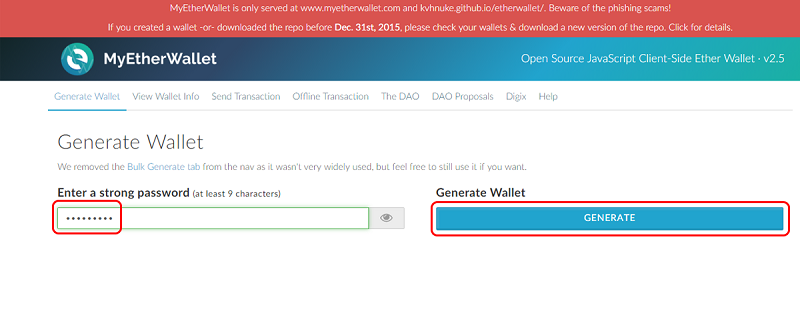
Step 2: Store your Private Key. You have 3 ways of doing this. You can download .JSON file with an encrypted version of the private key which is compatible with geth, mist and myetherwallet and requires a password to decrypt (Keystore). You can also store unencrypted version of your private key by downloading it in a .JSON file or by copy pasting it from the website. We recommend you use the Keystore (encrypted) feature, which provides an additional layer of security to your wallet.
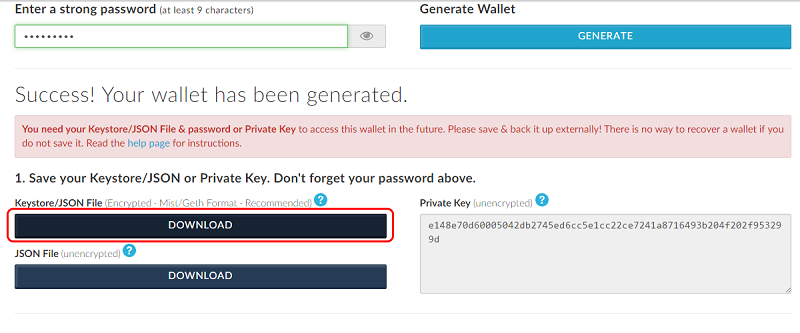
Step 3: Save your wallet address or QR code. In order to receive transactions you must give the sender a public key to which he can send the Ether to, you can copy the text format or the QR Code. The QR code can also be used to make a paper wallet.
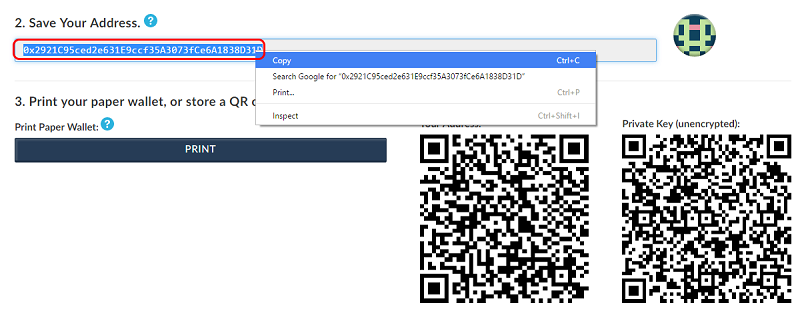
Step 1: Once you have your wallet you can now send and receive transactions. All you have to do is upload the private key file you have created through the MyEtherWallet website or mist/geth. Simply click "Send Transaction", select the type of private key you want to use (Keystore, Json file or Plain text) and click "Select wallet file".

Step 2: Select the wallet you want to use. You can check the wallet adress the key belongs to, by looking at the file name and adding "0x" in the beginning of the address. Mist wallet private keys are usually stored in .folder. Once you've selected the correct private key, type the password and click "Unlock wallet".

Step 3: Now all you have to do is fill out the Wallet you want to send Ether to, and how much you want to send. Click "Generate transaction" and then "Send transaction".

Step 4: One last confirmation window will appear, click "Yes, I am sure".

Step 1: If you want to make a transaction without the need to expose your Private key to an internet connection, you can use MyEtherWallet. Go to "Offline Transaction" and insert the wallet from which you're sending Ether. Click "Generate Information" and store the Gas Price and Nounce information.
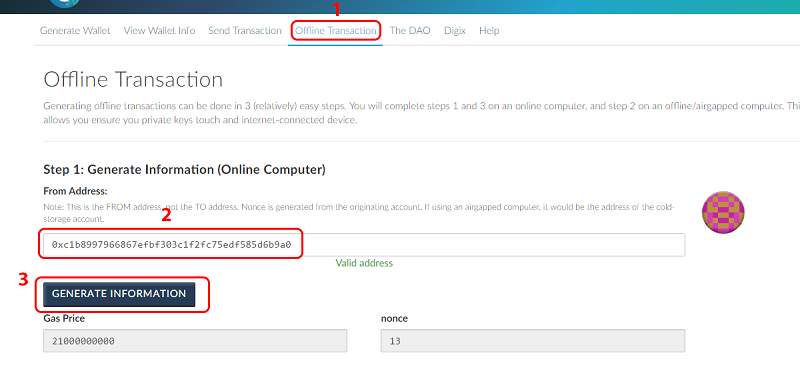
Step 2: Download the website here and move the files and extract them to an offline computer.

Step 3: Double-click "index.html" and choose "Offline transaction". The Website will look just like the online version.

Step 4: Enter the amount of Ether you want to send and the address you want to send it to. Insert the Gas and Nounce previously displayed in Step 1.
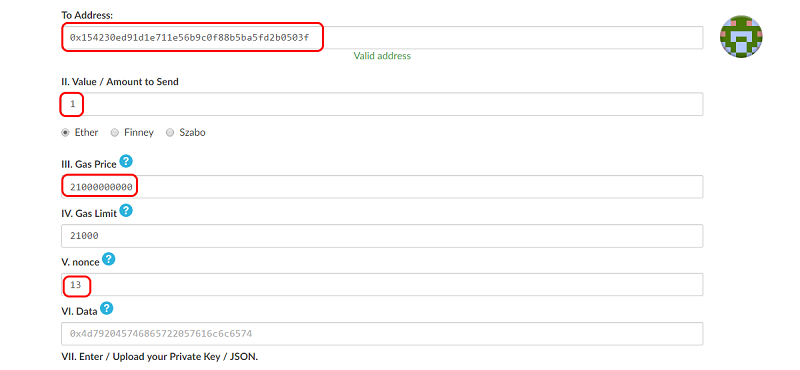
Step 5: Upload you Keystore file and unlock it with your password.

Step 6: "Click Generate Signed Transaction" and save the data displayed.

Step 7: Now you can broadcast the transaction to the blockchain, by visiting MyEtherWallet on computer with an internet connection, go to "Offline Transaction" again, paste the information and click "Send Transaction".

Step 8: One last confirmation window will appear, click "Yes, I am sure".

And that's it! You can now create an Ether Wallet within seconds and easily send a transaction without the need to download and broadcast the blockchain! And you can even protect yourself against nasty hackers and evil-doers by generating a transaction offline and broadcasting it on an online computer. Keep in mind that MyEtherWallet is constantly updated to support tokens such as TheDAO or DigixDAO, and it also has a "help" page that will cover any other subject that we didn't.
https://www.cryptocompare.com/wallets/guides/how-to-use-myetherwallet/
By: Antonio Madeira
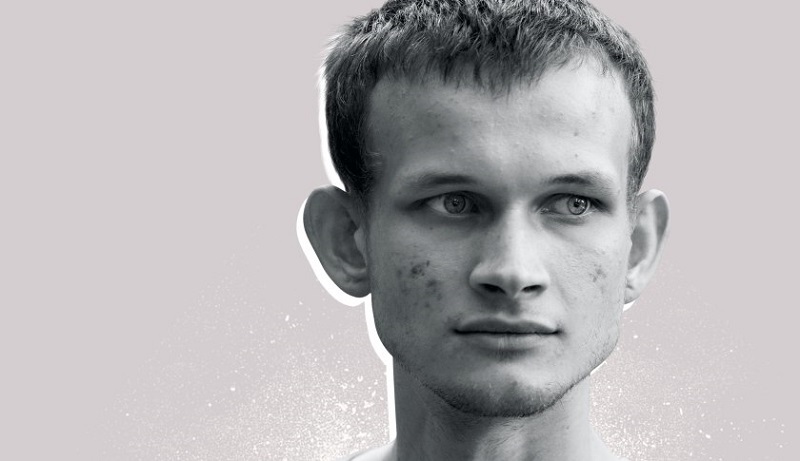
Buterin describes his open-source blockchain platform Ethereum as a “world computer.” The skinny visionary’s experiment, which began as a white paper, now has a market valuation of $48 billion, making it the second-most-valuable crypto network next to Bitcoin. Ethereum caught a lucky break this year when the SEC said it would not regulate Ether, the network’s native coin, as a security. Rumor has it Google recently tried to hire Buterin to lead its own whispered crypto endeavors, but he declined.